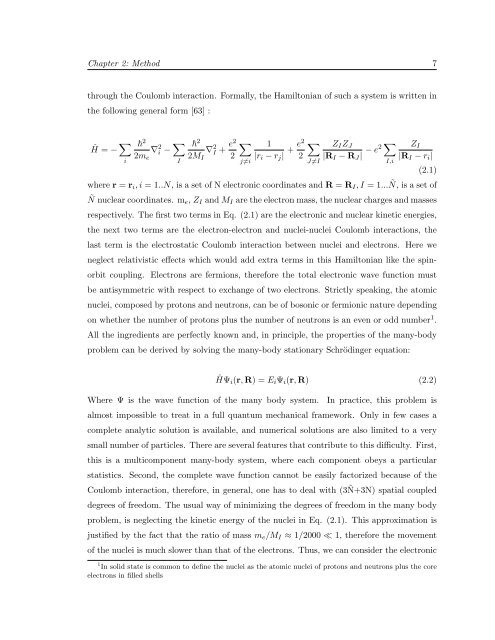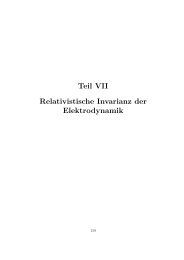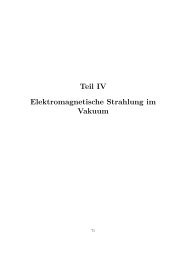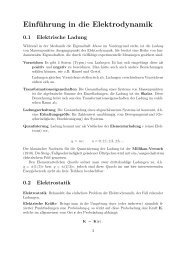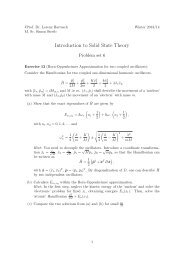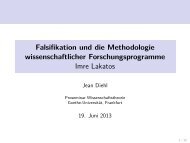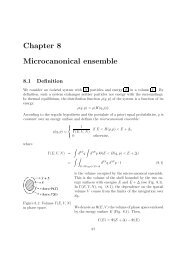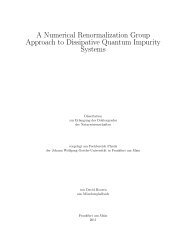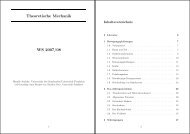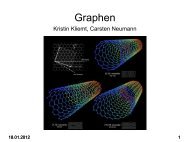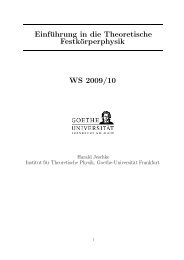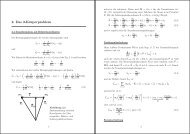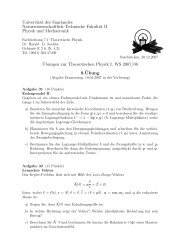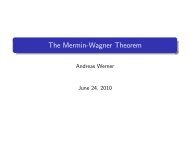Microscopic Modelling of Correlated Low-dimensional Systems
Microscopic Modelling of Correlated Low-dimensional Systems
Microscopic Modelling of Correlated Low-dimensional Systems
You also want an ePaper? Increase the reach of your titles
YUMPU automatically turns print PDFs into web optimized ePapers that Google loves.
Chapter 2: Method 7<br />
through the Coulomb interaction. Formally, the Hamiltonian <strong>of</strong> such a system is written in<br />
the following general form [63] :<br />
ˆH = − �<br />
i<br />
� 2<br />
2me<br />
∇ 2 i − �<br />
I<br />
� 2<br />
2MI<br />
∇ 2 I + e2<br />
2<br />
�<br />
j�=i<br />
1<br />
|ri − rj|<br />
+ e2<br />
2<br />
�<br />
J�=I<br />
ZIZJ<br />
� ZI<br />
− e2<br />
|RI − RJ| |RI − ri|<br />
I,i<br />
(2.1)<br />
where r = ri, i = 1..N, is a set <strong>of</strong> N electronic coordinates and R = RI, I = 1... Ñ, is a set <strong>of</strong><br />
Ñ nuclear coordinates. me, ZI and MI are the electron mass, the nuclear charges and masses<br />
respectively. The first two terms in Eq. (2.1) are the electronic and nuclear kinetic energies,<br />
the next two terms are the electron-electron and nuclei-nuclei Coulomb interactions, the<br />
last term is the electrostatic Coulomb interaction between nuclei and electrons. Here we<br />
neglect relativistic effects which would add extra terms in this Hamiltonian like the spin-<br />
orbit coupling. Electrons are fermions, therefore the total electronic wave function must<br />
be antisymmetric with respect to exchange <strong>of</strong> two electrons. Strictly speaking, the atomic<br />
nuclei, composed by protons and neutrons, can be <strong>of</strong> bosonic or fermionic nature depending<br />
on whether the number <strong>of</strong> protons plus the number <strong>of</strong> neutrons is an even or odd number 1 .<br />
All the ingredients are perfectly known and, in principle, the properties <strong>of</strong> the many-body<br />
problem can be derived by solving the many-body stationary Schrödinger equation:<br />
ˆHΨi(r, R) = EiΨi(r, R) (2.2)<br />
Where Ψ is the wave function <strong>of</strong> the many body system. In practice, this problem is<br />
almost impossible to treat in a full quantum mechanical framework. Only in few cases a<br />
complete analytic solution is available, and numerical solutions are also limited to a very<br />
small number <strong>of</strong> particles. There are several features that contribute to this difficulty. First,<br />
this is a multicomponent many-body system, where each component obeys a particular<br />
statistics. Second, the complete wave function cannot be easily factorized because <strong>of</strong> the<br />
Coulomb interaction, therefore, in general, one has to deal with (3Ñ+3N) spatial coupled<br />
degrees <strong>of</strong> freedom. The usual way <strong>of</strong> minimizing the degrees <strong>of</strong> freedom in the many body<br />
problem, is neglecting the kinetic energy <strong>of</strong> the nuclei in Eq. (2.1). This approximation is<br />
justified by the fact that the ratio <strong>of</strong> mass me/MI ≈ 1/2000 ≪ 1, therefore the movement<br />
<strong>of</strong> the nuclei is much slower than that <strong>of</strong> the electrons. Thus, we can consider the electronic<br />
1 In solid state is common to define the nuclei as the atomic nuclei <strong>of</strong> protons and neutrons plus the core<br />
electrons in filled shells


